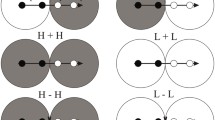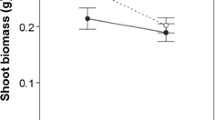Abstract
A clonal plant in heterogeneous environments is usually expected to profit from resource exchange via a clonal network where ramets placed in contrasting environments can specialise so to acquire the most abundant resources. An experiment was designed using the three member clonal system of Eriophorum angustifolium, which consisted of one parent ramet growing in a resource poor environment and two offspring: one was limited in growth by nutrients while the other was light limited; the contrast in availability of limited resources between the offspring ramets was high, medium or none, with the system either connected or severed. The total resource availability was the same in all treatments. We proposed four possible scenarios for the system: offspring ramets will share resources via the deficient parent ramet, and the whole clone will profit from the contrasting environment (scenario 1); offspring ramets will support exclusively the parent ramet, and the whole clone will profit from a homogeneous environment (scenario 2); offspring ramets will stop the export of the limiting resource to the parent ramet, with split and connected treatments not differing (scenario 3); and offspring ramets will exhaust the carbon stored in the biomass of the parental ramet; offspring ramet will profit from connection (scenario 4). In the experiment, the limiting resources were sent to the strongest sink (scenario 2). The parent ramet growing in a deficient environment received the highest support in the treatment where both offspring ramets were growing in the same conditions (no-contrast treatment). Production of new shoots, but not biomass of whole clone, was supported in a homogenous environment. The experiment revealed that multiple stresses might prohibit free exchange of limiting resources via the clonal network and supports the idea that experimental studies on more complex clones are essential for understanding the costs and benefits of clonal growth.





Similar content being viewed by others
References
Alpert P (1996) Nutrient sharing in natural clonal fragments of Fragaria chiloensis. J Ecol 84:395–406
Alpert P, Mooney HA (1986) Resource sharing among ramets in the clonal herb, Fragaria chiloensis. Oekologia 70:227–233
Alpert P, Stuefer JF (1997) Division of labour in clonal plants. In: de Kroon H, van Groenendael J (eds) The ecology and evolution of clonal plants. Backhuys Publisher, Leiden
Alpert P (1999) Clonal integration in Fragaria chiloensis differs between populations: ramets from grassland are selfish. Oecologia 120:69–76
Anon (1996) STATISTICA for Windows [Computer program manual]. Stat Soft, Tulsa, OK
Ashmun JW, Thomas RJ, Pitelka LF (1982) Translocation between sister ramets in two rhizomatous forest herbs. Ann Bot 49:403–415
Callaghan TV (1984) Growth and translocation in a clonal southern hemisphere sedge, Uncinia meridensis. J Ecol 72:529–546
Eriksson O, Jerling L (1990) Hierarchical selection and risk spreading in clonal plants. In: van Groenendael J, de Kroon H (eds) Clonal growth in plants. SPB Academic Publishing, The Hague, The Netherlands
Gómez S, Stueffer JF (2006) Members only: induced systematic resistance to herbivory in a clonal plant network. Oecologia 147:461–468
Hartnett DC, Bazzaz FA (1985) The integration of the neighbourhood effects by clonal genets in Solidago canadensis. J Ecol 73:415–427
Herben T (2004) Physiological integration affects growth form and competitive ability in clonal plants. Evol Ecol 18:493–520
Holzapfel C, Alpert P (2003) Root cooperation in a clonal plant: connected strawberries segregate roots. Oecologia 134:72–77
Hellström K, Kytöviita MM, Tuomi J, Rautio P (2006) Plasticity of clonal integration in the perennial herb Linaria vulgaris after demage. Funct Ecol 20:413–420
Huber H, Whigham DF, O’Neill J (2004) Timing of disturbance changes the balance between growth and survival of parent and offspring ramets in the clonal forest understory herb Uvularia perfoliata. Evol Ecol 18:521–539
Jónsdóttir IS, Watson MA (1997) Extensive physiological integration: an adaptive trait in resource-poor environments? In: de Kroon H, van Groenendael J (eds) The ecology and evolution of clonal plants. Backhuys Publisher, Leiden
Kelly CK (1995) Thoughts on clonal integration: facing the evolutionary context. Evol Ecol 9:575–585
Klimešová J, Klimeš L (2006) CLO-PLA3—A database of clonal plants in central Europe in. http://www.clopla.butbn.cas.cz
Lanta V, Doležal J, Šamata J (2004) Vegetation patterns in a cut-away peatland in relation to abiotic and biotic factors: a case study from the Šumava Mts., Czech Republic. Suo 55:33–43
Lepš J, Šmilauer P (2003) Multivariate analysis of ecological data using CANOCO. Cambridge University Press, Cambridge
Mágori K, Oborny B, Dieckmann U, Meszéna G (2003) Cooperation and competition in heterogeneous environments: the evolution of resource sharing in clonal plants. Evol Ecol Res 5:1–31
Magyar G, Kun Á, Oborny B, Stuefer JF (2007) Importance of plasticity and decision making strategies for plant resource acquisition in spatio-temporally variable environments. New Phytol 174:182–193
Marshall C (1990) Source-sink relations of interconnected ramets. In: van Groenendael J, de Kroon H (eds) Clonal growth in plants. SPB Academic Publishing, The Hague, The Netherlands
Marshall C, Price EAC (1997) Sectorality and its implications for physiological integration. In: de Kroon H, van Groenendael J (eds) The ecology and evolution of clonal plants. Backhuys Publisher, Leiden
Mooney HA, Winner WE (1991) Partitioning response of plants to stress. In: Mooney HA, Winner WE, Pell EJ (eds) Response of plants to multiple stresses. Academic, San Diego
Noble CJ, Marshall C (1983) The population biology of plants with clonal growth: II. The nutrient strategy and modular physiology of Carex arenaria. J Ecol 71:865–877
Oborny B, Kun Á (2002) Fragmentation of clones: how does it influence dispersal and competitive ability? Evol Ecol 15:319–346
Ong CK, Marshall C (1979) The growth and survival of severely-shaded tillers in Lolium perenne L. Ann Bot 43:147–155
Peterson AG, Chesson P (2002) Short term benefits of physiological integration in the clonal herb Hydrocotyle peduncularis. Austr Ecol 27:647–657
Phillips ME (1953) Studies in the quantitative morphology and ecology of Eriophorum angustifolium Roth: I. The rhizome system. J Ecol 41:295–318
Phillips ME (1954a) Studies in the quantitative morphology and ecology of Eriophorum angustifolium Roth: II. Competition and dispersion. J Ecol 42:187–210
Phillips ME (1954b) Studies in the quantitative morphology and ecology of Eriophorum angustifolium Roth: III. The leafy shoot. New Phytol 53:312–343
Phillips ME (1954c) Eriophorum angustifolium Roth. J Ecol 42:612–622
Pitelka LF, Ashmun JW (1985) Physiology and integration of ramets in clonal plants. In: Jackson JBC, Buss LW, Cook RE (eds) Population biology and evolution of clonal organisms. Yale University Press, New Haven
Price EAC, Marchall C, Hutchings MJ (1992) Studies of growth in the clonal herb Glechoma hederacea. I. Patterns of physiological integration. J Ecol 80:25–38
Roiloa SR, Alpert P, Tharayil N, Hancock G, Bhowmik PC (2007) Greater capacity for division of labour in clones of Fragaria chiloensis from patchier habitats. J Ecol 95:397–405
Roiloa SR, Retuerto R (2005) Presence of developing ramets of Fragaria vesca L. increases photochemical efficiency in parent ramets. Int J Plant Sci 166:795–803
Saitoh T, Seiwa K, Nishiwaki A (2002) Importance of physiological integration of dwarf bamboo to persistence in forest understorey: a field experiment. J Ecol 90:78–85
Salzman AG, Parker MA (1985) Neighbors ameliorate local salinity stress for a rhizomatous plant in a heterogeneous environment. Oecologia 65:273–277
Slade AJ, Hutchings MJ (1987) An analysis of costs and benefits of physiological integration between ramets of clonal perennial herb Glechoma hederacea. Oecologia 73:425–431
Sprugel DG, Hinckley TM, Schaap W (1991) The theory and practice of branch autonomy. Ann Rev Ecol Syst 22:309–334
Stuefer JF, de Kroon H, During HJ (1996) Exploiation of environmental heterogeneity by spatial division of labour in clonal plant. Funct Ecol 10:328–334
Stuefer JF, During HJ, de Kroon H (1994) High benefits of clonal intagration in two stoloniferous species, in response to heterogeneous light environments. J Ecol 82:511–518
Stuefer JF, Gómez S, van Mölken T (2004) Clonal integration beyond resource sharing: implications for defence signaling and disease transmission in clonal plant networks. Evol Ecol 18:647–667
Stuefer JF (1998) Two types of division of labour in clonal plants: benefits, costs and constraints. Perspect Plant Ecol Evol Syst 1:47–60
ter Braak CFJ, Šmilauer P (2002) CANOCO reference manual and CanoDraw for user’s guide: software for canonical community ordination (Version 4.5). Microcomputer Power, Ithaca, NY, USA
van Kleunen M, Fischer M, Schmid B (2000) Clonal integration in Ranunculus reptans: by-product or adaptation? J Evol Biol 13:237–248
van Kleunen M, Stuefer JF (1999) Quantifying the effects of reciprocal assimilate and water translocation in a clonal plant by the use of stem-girdling. Oikos 85:135–145
Yu F, Dong M, Krüsi B (2004) Clonal integration helps Psamochloa villosa survive sand burial in an inland dune. New Phytol 162:697–704
Zanne AE, Sweeney K, Sharma M, Orians CM (2006) Patterns and consequences of differential vascular sectoriality in 18 temperate tree and shrub species. Funct Ecol 20:200–206
Zhang C, Yang C, Dong M (2002) Clonal integration and its ecological significance in Hedisarum leave, a rhizomatous shrub in Mu Us Sandland. J Plant Res 115:113–118
Acknowledgements
We thank Jiří Doležal, Leoš Klimeš and Jan Š. Lepš for helpful comments on the manuscript and to Keith Edwards for linguistic correction. This research was supported by the Grant Agency of the Czech Republic (GA526/06/0723) and by research project of Institute of Botany AS CR (AV0Z60050516).
Author information
Authors and Affiliations
Corresponding author
Rights and permissions
About this article
Cite this article
Janeček, Š., Kantorová, J., Bartoš, M. et al. Integration in the clonal plant Eriophorum angustifolium: an experiment with a three-member-clonal system in a patchy environment. Evol Ecol 22, 325–336 (2008). https://doi.org/10.1007/s10682-007-9203-7
Received:
Accepted:
Published:
Issue Date:
DOI: https://doi.org/10.1007/s10682-007-9203-7




